Quick search
CTRL+K
Quick search
CTRL+K

Lübeck was the queen of the Baltic Sea Region’s Hanseatic cities. It still is, and that is not without reason. Majestic churches and countless houses, monasteries and other medieval buildings stand as evidence of the immense wealth that came to the city over the centuries with trade routes.
The old town of Lübeck is located on an island in the Trave River, which provides a natural boundary for this part of the city where everything is within walking distance. In addition, the river and its banks are like a blue-green belt around the city, which can be enjoyed in many places, for example on a river boat, where you sail the Trave around the center of Lübeck.
There are many interesting sights in Lübeck’s center with the city’s many great medieval churches at the forefront. Marienkirche and Lübeck cathedral are the two most well-known churches, which form the famous skyline of the Hanseatic city. You can also enjoy nice squares and other famous buildings such as the city hall and the city gates Holstentor and Burgtor.
As one of Northern Germany’s largest cities, there is a rich selection of culture, museums, shopping and gastronomic experiences in Lübeck. Much of it takes place in the medieval surroundings of the city’s old and cozy buildings, and among the more recent things to see is the beautiful and tasty marzipan salon. Here are various delicacies of the famous Lübeck marzipan.
It is easy to get to the countryside and to other cities and towns as well. It is not far to i.e. Hamburg, Schwerin and Wismar with great sights and many activities. You can also enjoy the lakelands around Plön and Eutin or make a day to the lovely beaches in Travemünde or the island of Fehmarn.
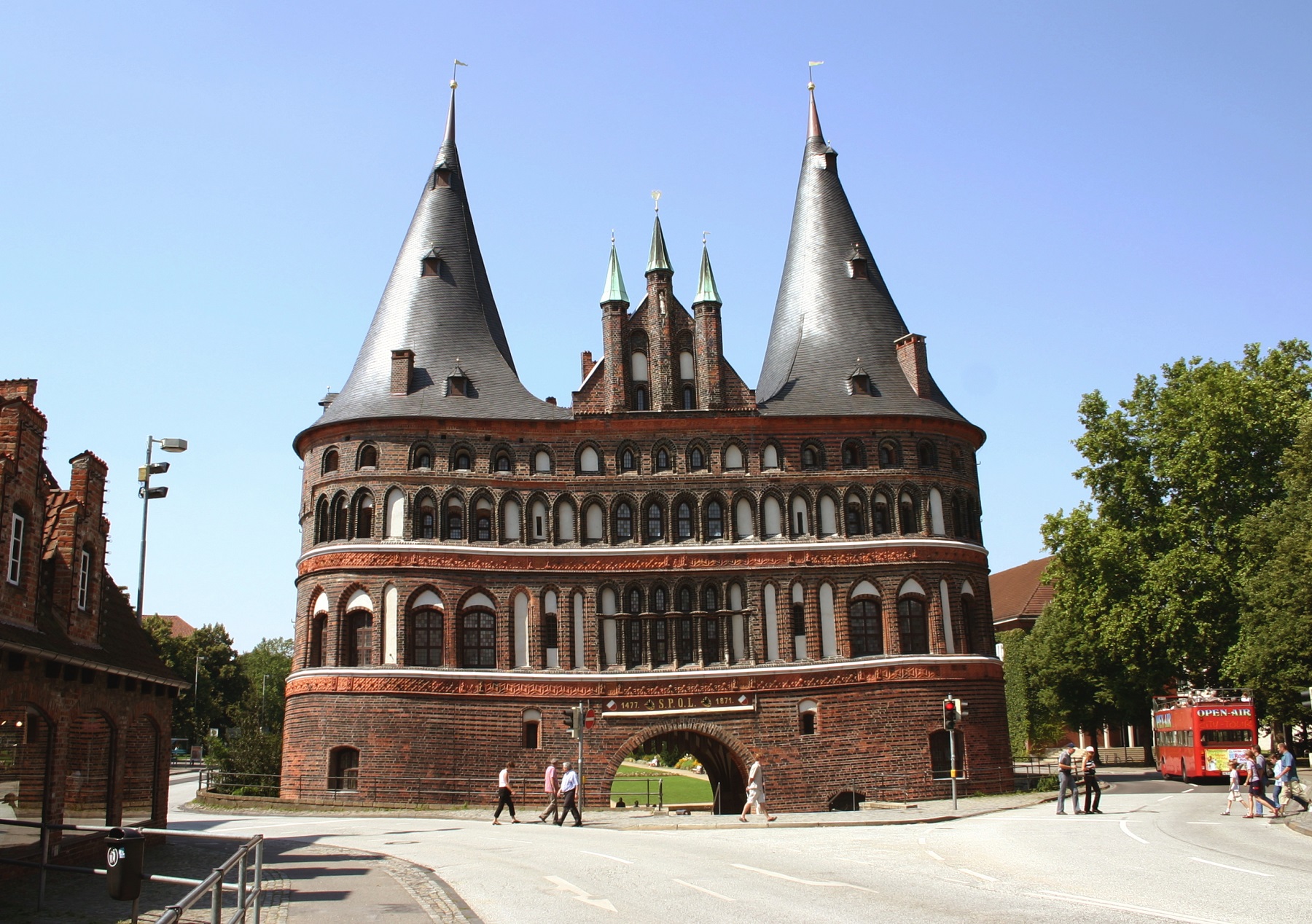
The impressive city gate Holstentor was built 1464-1478 as part of the city’s defenses. The gate is today Lübeck’s landmark. Since its construction, Holstentor has literally sunk into the ground, so today the gate looks crooked, among other things one tower leans somewhat. A renovation and stabilization was carried out in 1933-1934, when it was believed that there was a danger of a collapse.
Originally, there were three simultaneous Holstentors – one inner, one middle and one outer. The preserved one is the middle one, while the inner one was demolished in 1828. The outer gate fell in 1853 in favor of Lübeck’s first railway station – you can see it as a model in a display case on the road west of Holstentor.
Holstentor consists of three building parts; the central gatehouse and two flanking towers with conical tops. Since 1950, the interesting city museum has been located in Holstentor. Here, among other things, the trade and seafaring that created the successful Hanseatic city are depicted.
There are several different canal and harbor tours in Lübeck. The area where the boats sail from was the old transshipment point for salt coming from Lüneburg. The salt was resold at great profits and shipped from the harbor basin to the north. Ships sailed to large parts of Europe with the salt, which was one of the reasons for the city’s wealth.
On the boat trip around Lübeck you can enjoy the many small and large buildings from the water side, and it is a special experience, not least the view of the city skyline with the towers of all five large churches.
West of Lübeck city center you can sail on the city’s moat, the Stadtgraven, which was excavated as one of several defenses against outsiders who wanted to conquer or rob the rich city. The excavation is a good 20 meters wide, up to 10 meters deep and goes in a zigzag pattern, so it was more difficult for enemies to take Lübeck from the lake side.
From the tour you can also see the start of the 67 kilometer long canal that connects Lübeck and the Elbe. The canal was opened in 1900, when Lübeck became an integral part of Germany, but already in 1390-1398 a precursor, the Stecknitz Canal, was dug, which ran slightly differently from the current canal.
If you want to spend more time on the water, you can, for example, sail all the way to the mouth of the Baltic Sea at the port town of Travemünde.
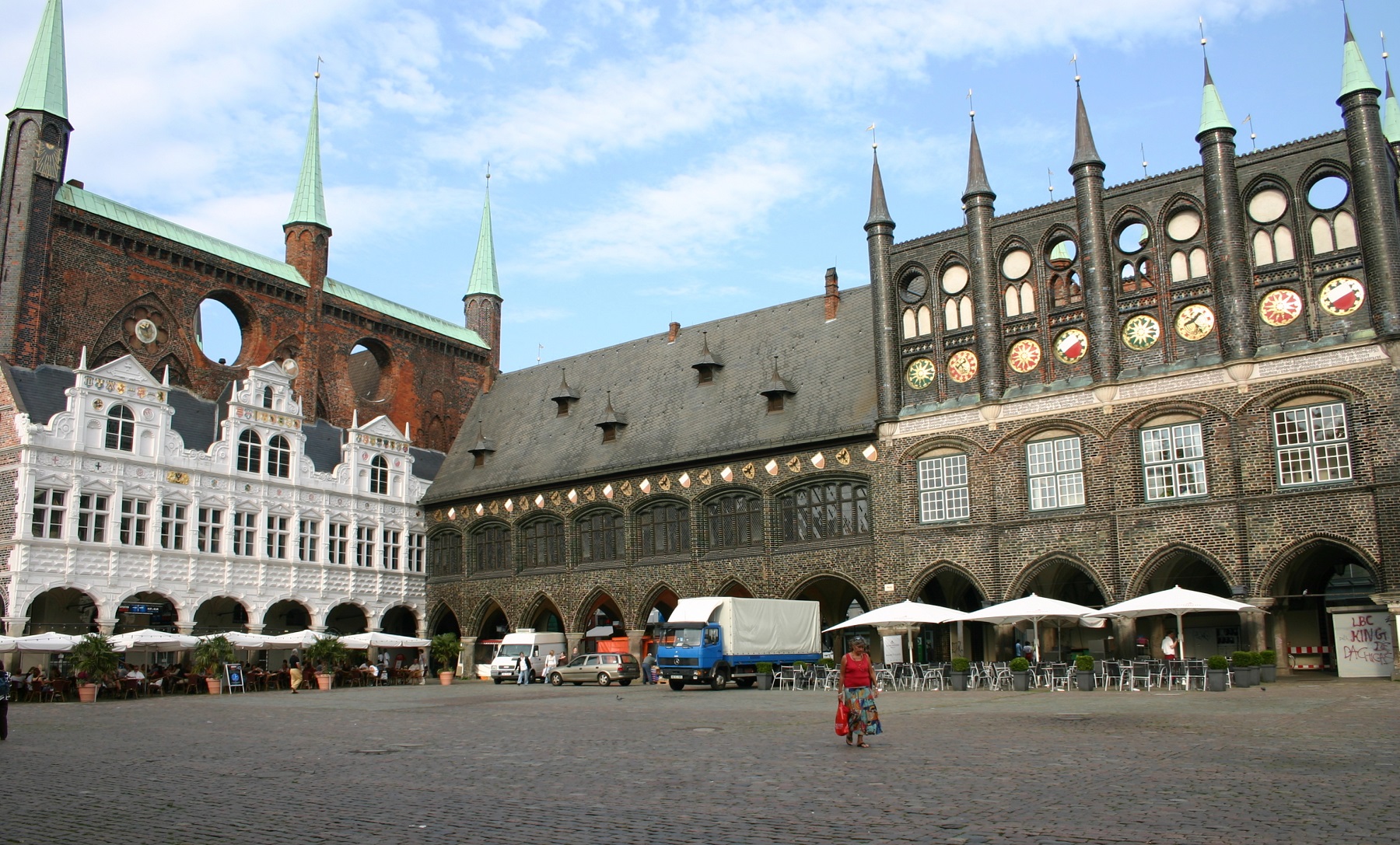
Construction of Lübeck’s town hall started shortly after the city gained its freedom in 1226. The earliest construction was in the late Romanesque style, and parts of it have been preserved in the south wall. In 1308 the actual town hall was completed.
In 1435, the town hall was expanded with a new wing, De Nye Gemakker/Neuen Gemachs, which is late Gothic in style. Neuen Gemachs is the wing with the small towers. In the latter half of the 16th century, the elegant sandstone Renaissance building was built with a facade facing the market square, and in 1594 the beautiful staircase facing the Breite Straße was erected.
The town hall buildings housed Lübeck’s administration, and here were also functions for the Hanseatic League, e.g. the Hanseatic council itself and the courts. The city’s mayor and city council still sit in the old buildings, and they also use the building to the north along Breite Straße.
The town hall buildings are exciting with their archways, coats of arms and varied architecture, and they are particularly worth seeing inside. However, access is limited. In the large foyer facing Breite Straße is an impressive staircase and a portal from 1574. On a tour you can see, among other things, pictures of scenes from the founding of the city, several beautiful rooms and halls and imagine where the historic Hansesal/Hansesaal was located. The Hanseatic Hall was closed down in 1818, and the hall was then used as administrative premises.
Hospital of the Holy Spirit is one of the world’s oldest social institutions and at the same time a magnificent example of a monumental medieval building. As early as 1286, the hospital was established and furnished for poor and sick citizens.
Originally, there were beds in the large hall on the ground floor, while later an actual hospital was set up on the upper floors. During the Reformation period, the site was converted into a home for the elderly, and until 1970 there were residents in the small cabins in the large old hall. Other parts of the complex are still rest and nursing homes.
The front hall is set up in the site’s original church, and the small cabins in the large hall were originally built in the early 1800s.
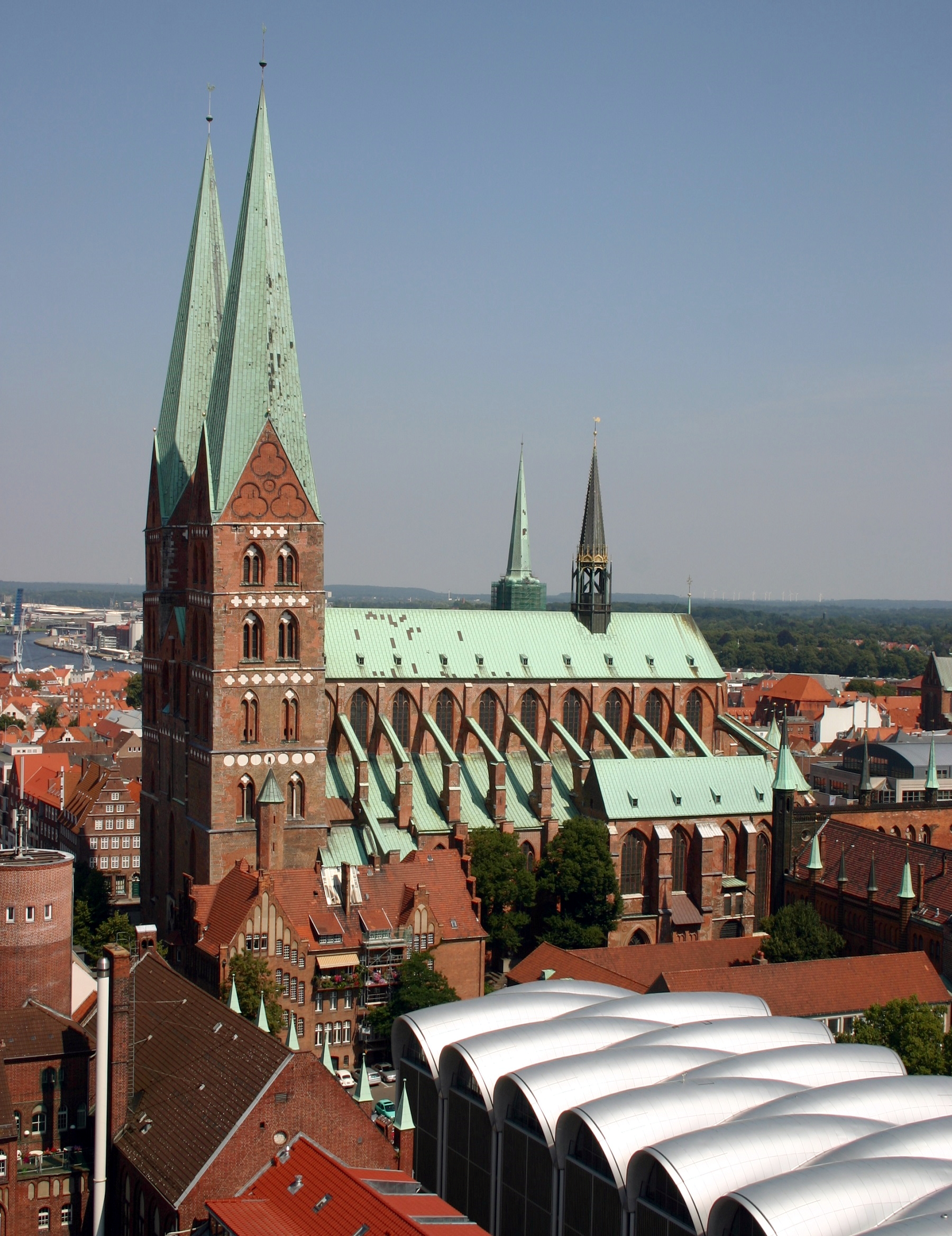
The mighty Marienkirche is Germany’s third-largest church building, and it has acted as inspiration for countless brick churches throughout the ages in the Baltic Sea area.
The church was built 1250-1350 and stood as the symbol of Lübeck’s wealth and prosperity. Before then, there was a smaller church on the site, but with inspiration from Gothic churches in France and Flanders, the new construction was started. At 125 meters, Marienkirche was and is the tallest building in the center of Lübeck, and it created respect for the city as a leader in the northern German area.
Over time, the church received many gifts, and over time there were no less than 38 altars. 84 wooden epitaphs and some in stone were also added.
The church reigned over the city for centuries, until the Allied bombardment on 28-29 March 1942. The church was heavily damaged as a result of the fire after the bombs and stood as a partial shell without the high spiers. In the south tower you can see a memorial chapel where there are remains of the church bells; they lie exactly as they fell in 1942.
A temporary roof was put over the Marienkirche after 1942. The reconstruction of the church was started in 1947, and by 1959 the majority of the work was completed. Details were added later, among other things, the church’s small spire in the middle of the roof was only erected in 1980.
Inside, the world’s highest brick vault opens up with a whopping 38.5 meters to the ceiling. After the fire in 1942, there were wall paintings that could be saved. Work started in 1948 under the direction of Dietrich Fey.
In addition to restored wall paintings, you can see the preserved epitaphs in stone. At the church’s altar you can see an astronomical clock that was built 1960-1967 by the Lübeck watchmaker Paul Behrens. The clock replaced the earlier one from 1561-1566, which perished in 1942. The church’s bells are partly from the period after the Second World War and partly from St. Katharina’s Church in present-day Gdansk.
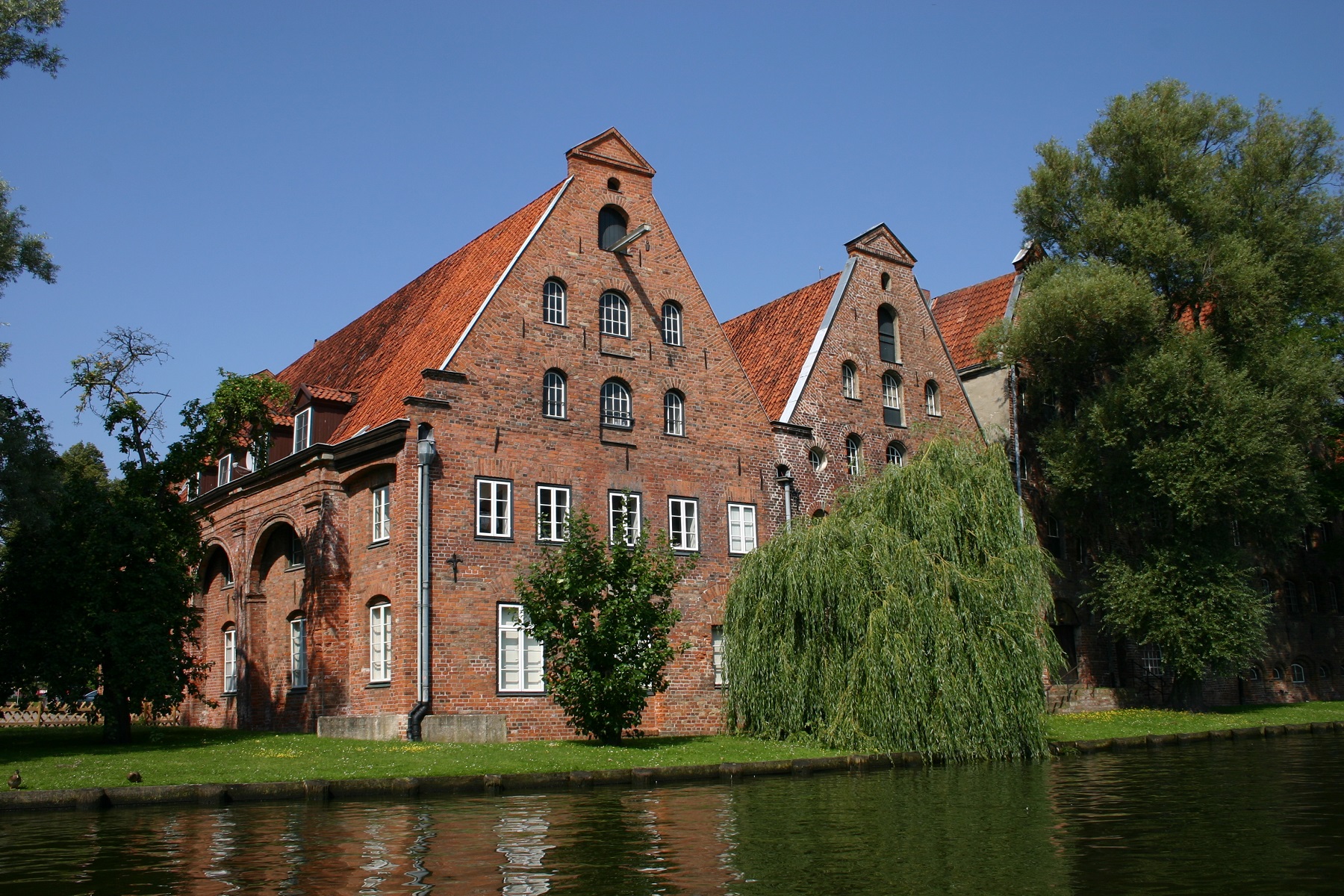
Salzspeicher is the name of six warehouse buildings along the Trave river. They were built in the period 1579-1745. The buildings were used to store the salt that was shipped here from the Lüneburg area. The salt was exported not least to Scandinavia, where large fish catches had to be preserved. Today, shops are set up in the old and beautiful houses.
Saint Peter’s Church was first consecrated in 1170, but a major building work of a three-nave late Romanesque church building took place 1227-1250. In 1290, a Gothic map was added, and in the 15th century, the interior of the church came to be five naves. During the bombing in 1942, the church was hit and burned to the ground along with the beautiful interior. The church was rebuilt in the years up to 1987, but already in 1961 the beautiful church tower was completed.
In the 108 meter high tower there is a viewing platform at a height of 50 metres. With its location in the middle of Lübeck’s old town, there is a beautiful and exciting view from here. The church is not used for church services today, but instead for various exhibitions and concerts.
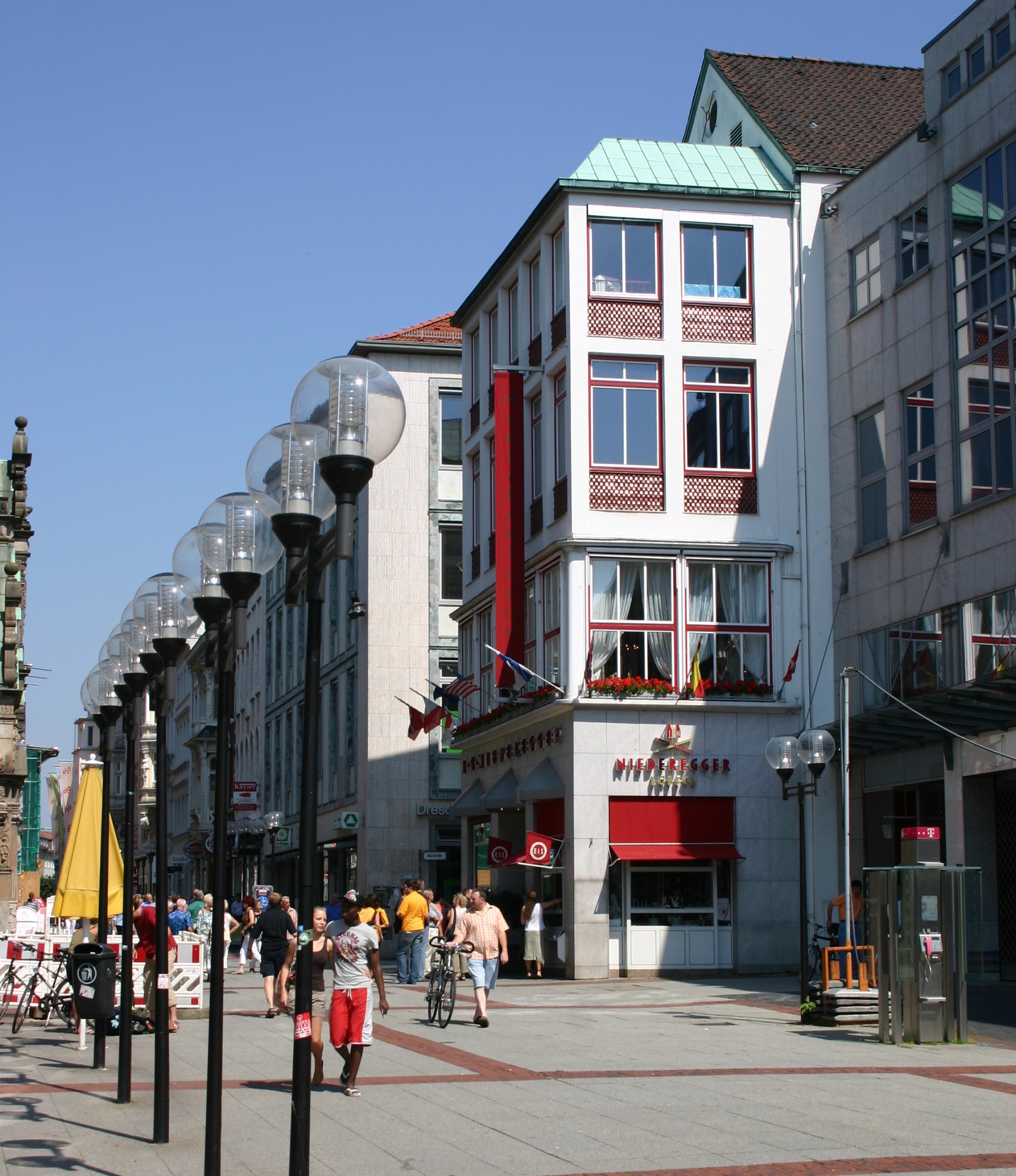
Lübecker marzipan is probably something most people know, and since 1806 the company Niederegger has been producing the sweet almond mass here in the city. The so-called Marzipan-Salon is located on the 2nd floor of Niederegger’s building, and here you can learn about marzipan production and the history of marzipan, among other things.
The ground floor of the building is a tempting shop with marzipan in all shapes and colors, and at the back and on the 1st floor is a patisserie, where you can of course taste cakes with marzipan. The whole building is very beautifully decorated.
The Lion Pharmacy is one of Lübeck’s oldest preserved secular buildings; parts of the structure even date back to the time before the great city fires of the 13th century. The current brick house with a jagged gable was built in 1230 by the councilor Bertram Stalbuk. The Gothic profile on the main gable was added during a rebuild in 1358, while the house’s smaller gable dates from 1403.
Over the centuries, the house was home to several of the city’s prosperous families; among other things, some of Lübeck’s mayors have lived here over time. The place became a pharmacy in 1812, when the pharmacist Adolf Christoph Sager moved in. The pharmacy was destroyed in 1942, but later rebuilt.
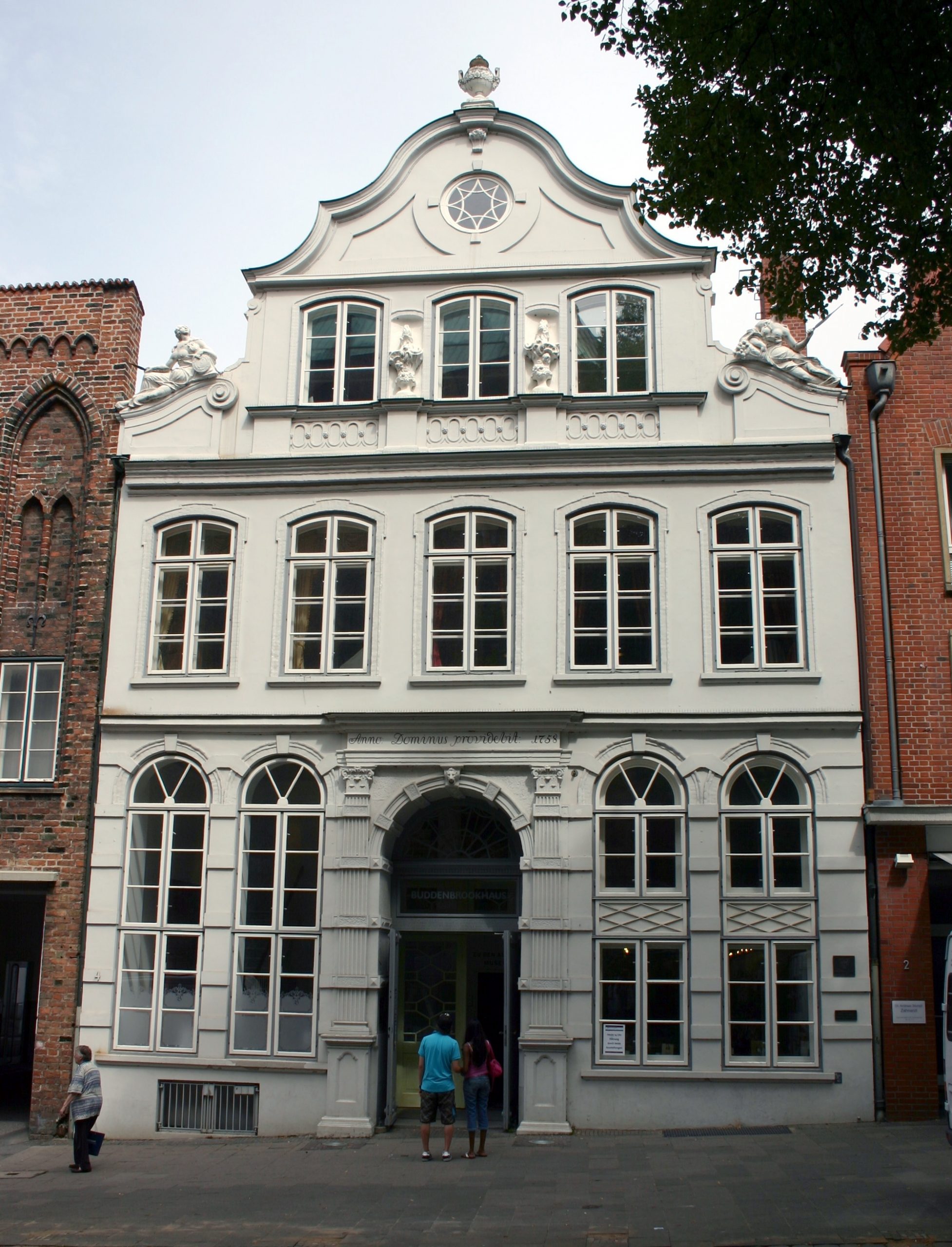
This house is the setting for Thomas Mann’s Nobel Prize-winning novel Buddenbrook. The Mann family lived in the beautiful old town house from 1758, and it is now set up as a museum with a fine 19th-century interior.
At the museum you can see an exhibition about the brothers Thomas and Heinrich Mann, and there is also an exciting and quite lively exhibition about the novel Buddenbrook.
St. Catherine’s Church is the only preserved monastery church in Lübeck, and it is today set up as a museum church. It was built in noble brick Gothic as part of a Franciscan monastery dedicated to Saint Catherine of Alexandria. The Franciscans acquired the plot of land in 1225 and built a monastery and the first church. The current church is from the 14th century.
After the Reformation in 1531, the monastery buildings were arranged as a Latin school and from the 17th century also as a library. The church continued to function as a church. In 1841, the first collection of works of art from the Middle Ages was established in the choir, and the rest of the church was used for exhibitions and concerts throughout the 19th and early 20th centuries.
When many of the city’s other churches were destroyed during a bombardment in 1942, St. Katharina Church was once again established and used as a church. Since 1980 it has been a museum, and there is still a school on the monastery grounds; Katharineum.
Inside the museum you can see, among other things, the Venetian Tintoretto’s mural of the Resurrection of Lazarus and a copy of Bernt Notke’s statue of St. George and the Dragon. The original stands at Storkyrkan in Stockholm.
On the facade of the church is the interesting tilework by Ernst Barlach and Gerhard Marck’s interesting figure frieze, which dates from the years 1929-1949.
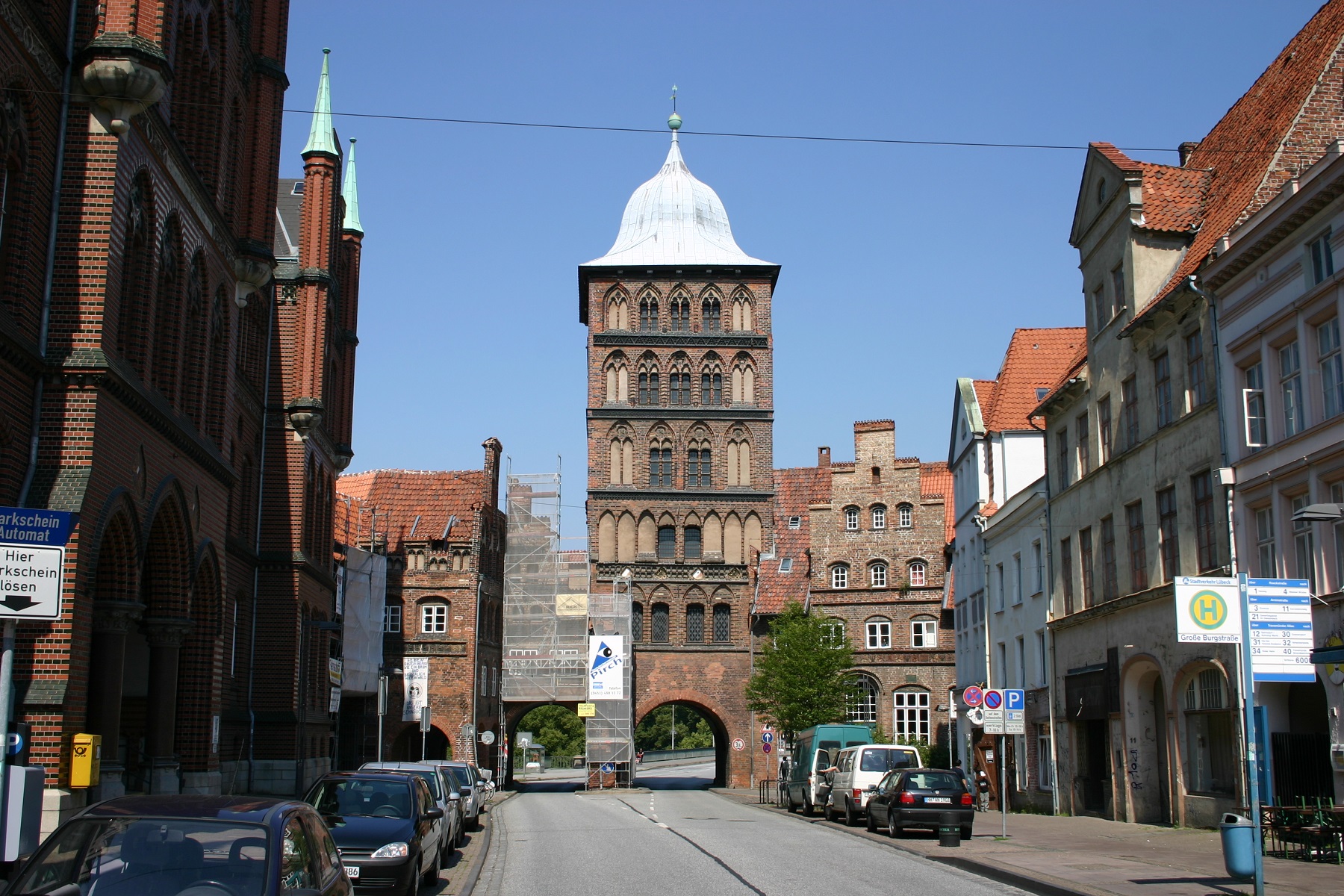
The castle gate is the northernmost of Lübeck’s four old city gates. It was built in 1444 in late Gothic style, but the tower cap was only added in 1685. The gate’s name refers to the former Lübeck Borg/Lübecker Burg, which was located above the Trave river and which in 1227 was converted into a monastery.
Originally there was only one entrance through the main gate, but increased traffic has given three new accesses to and from the city. They came into being from 1850 to the end of the 1920s.
Historically, it was precisely through the Castle Gate, French troops came through the city’s defenses on 6 November 1806 during the Battle of Lübeck, which resulted in French rule over the free city.
The writer, artist and Nobel laureate Günter Grass lived for many years in Lübeck, where this museum is now located. Among Grass’s works is Bliktrommen (Die Blechtrommel) from 1959, and he received the Nobel Prize in Literature in 1999.
The museum tells a wide story about Günter Grass and his works. There are more than a thousand effects in the exhibition; including manuscripts, lithographs and sculptures.
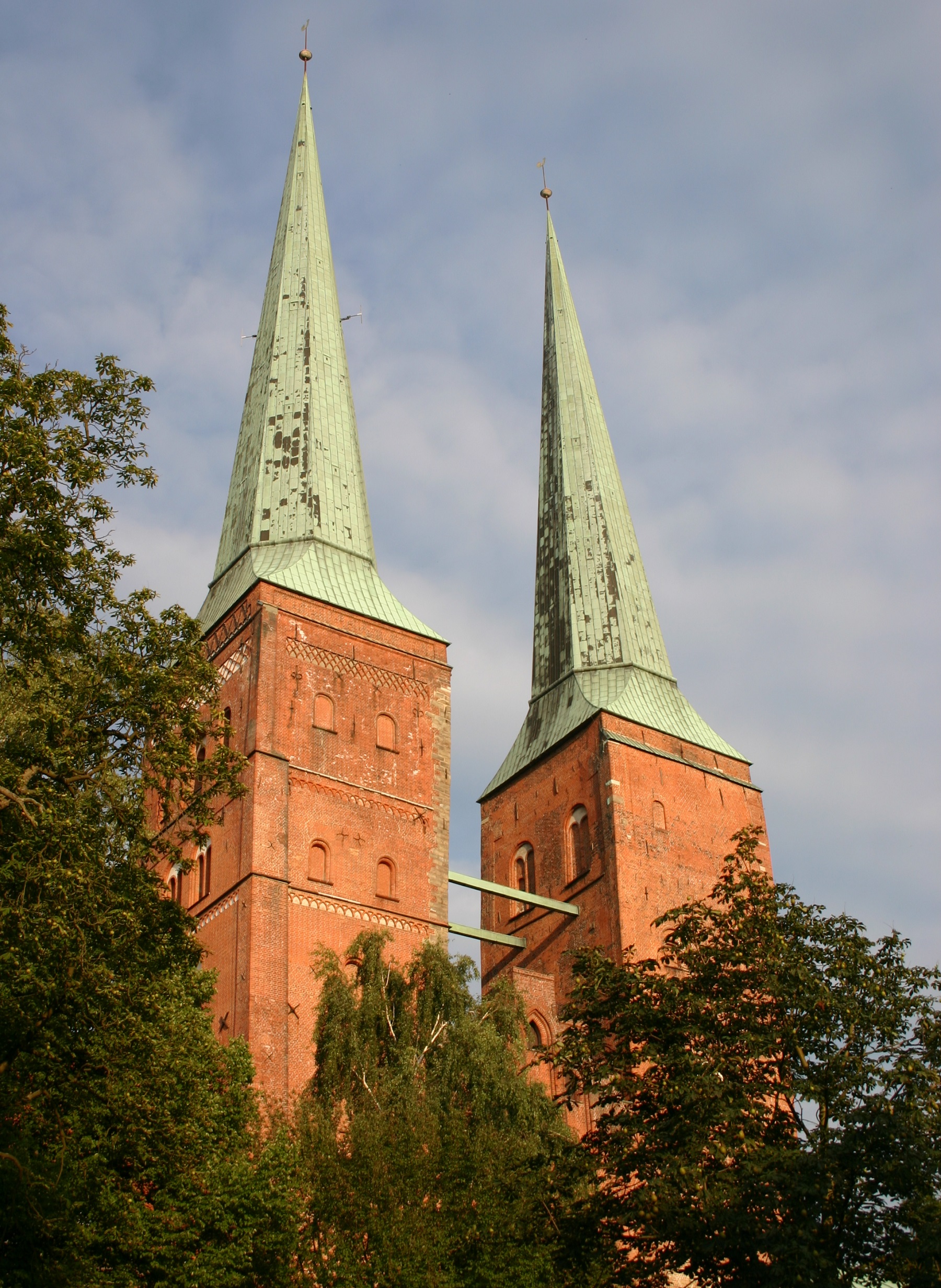
Lübeck’s cathedral is the city’s oldest preserved building. After the city became a bishop’s seat in 1160, a large church had to be built, and Henry the Lion laid the foundation stone for the cathedral 13 years later.
It is said that Henry the Lion competed with his son as to which of the two could finish building a tower first. The son won, and on top of that he built his own tower 2 meters higher than the father’s. The height of the cathedral is 114 metres, and with 130 meters in length it is an impressive church.
The new Romanesque brick church replaced a wooden church on the same site. It was completed in 1230 and consecrated in 1247. In the years 1266-1335, the church was rebuilt in Gothic style, and in this connection the side naves were built to the same height as the central nave.
During an air raid in 1942, the cathedral was heavily damaged, but fortunately part of the inventory was saved. Reconstruction after the war did not begin until 1960, and in 1982 the work was completed.
Among the interior of the church are several burial chapels, Bernt Notke’s 17 meter high Triumfkors/Triumphkreuz from 1477 and the pulpit from 1586. The beautifully decorated lecture room is like the triumphal cross from 1477, and the large church clock on it is from 1628.

Holsteinische Schweiz is a beautiful lake, forest and hill landscape located in the area between the cities of Lübeck and Kiel. It didn’t get its nickname from nothing, because it is a lovely and very varied nature that you come across on a trip here, and there are also several interesting towns in the area.
Plön, Eutin and Malente are the most well-known and popular towns in Holsteinische Switzerland, and you can visit them with advantage. Plön is very cozy and known for the castle Plöner Schloss, which has a panoramic view of the lake Großer Plöner See, which you can also go on boat trips on. From the boats there is an excellent view of the castle, which was built in the 17th century and which was the ducal residence over the years.
In Eutin, you can start a stroll on Marktplatz and Kirchplatz, the city’s central square. Here you can see, among other things, the church of St. Michaelis. The beautiful Eutiner Schloss from the 1700s and 1800s is also located in the city. Malente is also a cozy town that has been known as a spa town for centuries, and here you can also go on sailing trips in the beautiful countryside.

Hamburg, with more than two million inhabitants, is Germany’s second largest city and the absolute metropolis of northern Germany. Its wealth has been created over the centuries as a successful member of the Hanseatic League, where Hamburg grew large as a port city, and to this day the maritime element is a continuing source of trade and tourism.
Hamburg is one of Central Europe’s great gates to the world. The trade has gone through the city for centuries, which now has lovely business districts, markets and lots of sights. Life around the harbor has been greatly developed in recent years, with the historic warehouses of Speicherstart being transformed into activities, offices and with housing and cultural institutions blended beautifully into the old settings.
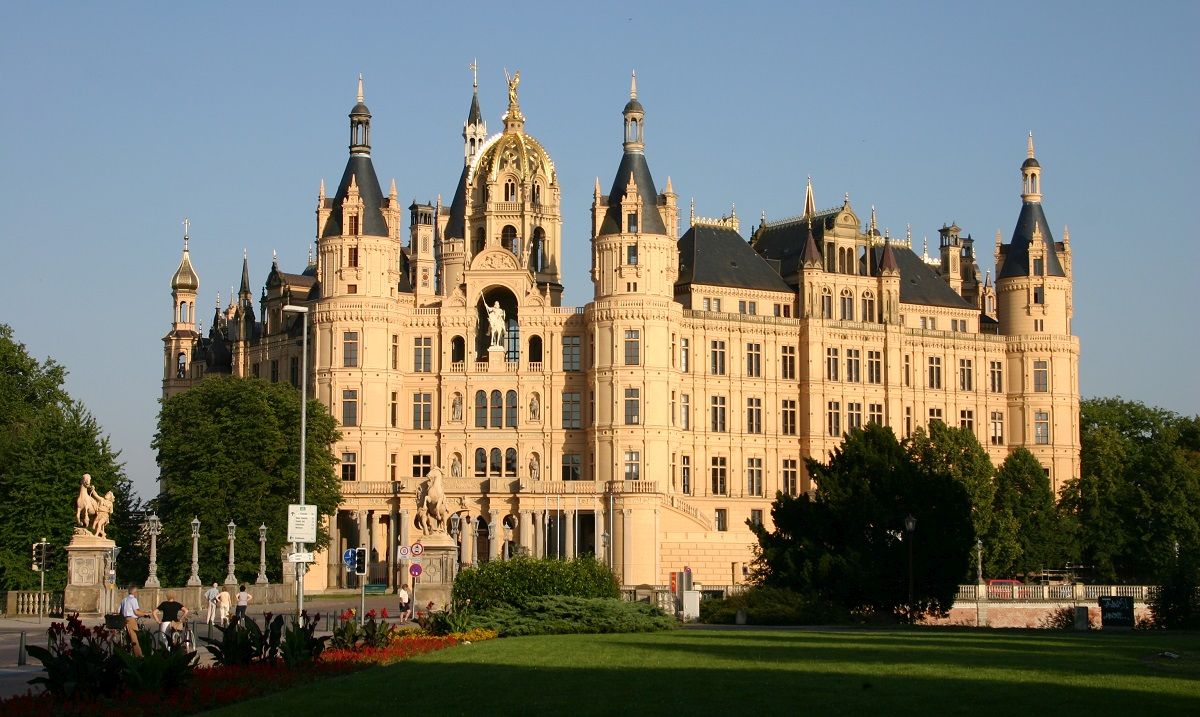
Schwerin is the capital of the state of Mecklenburg-Western Pomerania and the historic residence city of the dukes and grand dukes of Mecklenburg-Schwerin. It is the home to loads of elegant and magnificent buildings in the beautifully situated town on the lake Schweriner See, where you can enjoy various lovely lake cruises.
The most famous building is Schwerin Palace, which is a true fairy tale castle with its many towers and spiers. It is a must to visit during a tour of the city, but there are also many other large buildings within a pleasant walking distance. Along the way you can enjoy the fine pedestrian streets and squares located in the old town.

Wismar is one of the historic North German Hanseatic cities, where you can see many old buildings in the so-called Brick Gothic architecture. The architecture is typical of the once prosperous cities of the Hanseatic League, and among other things, the three major churches radiate the atmosphere from the city’s economically thriving commercial history.
The churches of St. Georgen and St. Nikolai stand beautifully as the great old churches that are. The third of Wismar’s three mighty churches, the Marienkirche, was destroyed during World War II and is today it is only the church tower with the contours of the other buildings which remains. It provides an interesting perspective in the old center of the city.
Sandstraße 1
haerder-center.de
Königstraße 54-56
karstadt.de
Königstraße 55
koenigpassage.com
Konrad-Adenauer-Straße 2
Breite Straße, Königstraße, Hüxstraße, Fleischhaurstraße
TheaterFiguren-Museum
Kolk 14
tfm-luebeck.com
Hansa Park
Sierksdorf
hansapark.de
Hafenrundfahrt
An der Obertrave, An der Untertrave, Holstentor
quandt-linie.de
luebecker-barkassenfahrt.de
Tierpark Lübeck
Waldstraße 2
tierpark-luebeck.de
Museum für Natur und Umwelt
Mühlendamm 1-3
die-luebecker-museen.de
Niederegger Marzipan Salon
Breite Straße 89
niederegger.de
The area around Lübeck was inhabited by Slavic people in about 700 years. Many of the former Anglo-Saxon residents of the present Schleswig-Holstein had, during the centuries of migration, abandoned the site in favor of today’s England.
At the beginning of the 8th century, the ruler of France, Charles the Great, brought other people, and they founded the city of Liubice on the banks of the River Trave. Liubice became the most important of the cities of Slavic obituaries, but in 1129 it was burned down by the Rani people of Rügen.
In 1143, Adolf II of Schauenburg and Holstein founded the German city of Lübeck on the site of Bucu, whose name comes from the Slavic castle which was located at the place where the Burgkloster now lies. In 1158, Adolf II lost his castle on the site to Henrik Løve, who ruled Lübeck until 1181. He granted the city city rights in 1160 following the example of the city of Soest. It then became a free state city for a few years before the German-Roman emperor Frederick Barbarossa set up a city council whose rule came into force in Lübeck until the 19th century.
Although the city had obtained its own city government, it was subject to changing rulers the following time. Until 1197 it belonged to the Duchy of Saxony, Holstein until 1217 and Denmark until 1227. From 1226, Emperor Frederick II had made Lübeck a free city state, and it retained it under various forms and rulers until 1937.
Around 1200, Lübeck became a shipping port for settlers who took to the Baltic areas which the Liveland Order and later the German Order conquered.
In the 1300s, Lübeck became the so-called queen of the Hanseatic League. It was the most powerful and strongest member of trade cooperation. The Hanseatic cities extended from the original northern German cities to large parts of the Baltic Sea and later elsewhere in Northern Europe. In 1356, the first Hanseatic days were held in Lübeck.
In 1375, Emperor Charles IV appointed five wonders of the empire; Lübeck, Florence, Pisa, Rome and Venice.
Lübeck and the other cities of the Hanseatic League flourished, and enormous wealth went to and through the cities. The biggest challenge was the many battles against Denmark, whose cities were outside the Hanseatic League. Lübeck won conflicts with Denmark in 1435 and 1512, but became involved in the Danish civil war, the Count’s Feud, 1534-1536. Lübeck was on the losers’ side in the Count’s Feud, and then the city’s role slowly diminished.
In 1629, the peace in Lübeck was signed. The peace ended Denmark’s participation in the Thirty Years War, a war in which Lübeck managed to remain neutral.
The Hanseatic League held the last Hanseatic days in 1669, and then the old and formerly successful trade union was de facto dissolved. New trade routes across the Atlantic had arrived, but Lübeck’s position as a trading town in the Baltic Sea was maintained.
With the dissolution of the German-Roman Empire on August 6, 1806, Lübeck became a sovereign state for the first time. Already on November 6, the same year, French troops occupied the city after a battle against German troops led by Gebhard Leberecht von Blücher.
In the years that followed, Lübeck suffered commercially from the restrictions of the Continental Blockade imposed by France against England and its allies. In addition, from 1811 to 1813, Lübeck formally became part of the First French Empire. In 1813, Lübeck regained his status from before 1811, and after the Vienna Congress in 1815, Lübeck gained his status as a sovereign city state. Together with 38 other German states, the city was a member of the German Confederation, and from 1866 a part of the military alliance of the Northern German Confederation, which had Prussia as the leading state out of the 22 included.
In 1871, Lübeck became an autonomous part of the newly formed German Empire. At this time, approximately 52,000 inhabitants lived in the city, a number that grew to nearly 100,000 during the 19th century.
In 1937, the Nazi regime passed the law Law über Groß-Hamburg and other Gebietsbereinigungen. It included a swap of land between the states of Hamburg and Prussia. For Lübeck, that meant that the city’s freedom ended and most of the land was subject to the state of Schleswig-Holstein, which belonged to Prussia. A smaller part of Lübeck came under Mecklenburg.
During World War II, Lübeck was the first German city to suffer heavy aerial bombardments. The largest attack was launched on March 28, 1942, and Lübeck fell victim to a fire that ravaged and destroyed large parts of the Old Town; among others, most of the city’s great medieval churches. The city was conquered without resistance by British soldiers on May 2, 1945. During the war years, the city’s population increased from 150,000 in 1939 to around 220,000 after the war, one of the reasons being many new arrivals from the lost German eastern territories in 1945.
From 1945 the planning of the large-scale reconstruction could begin, and one of the earliest major projects became the largest church, the Marienkirche, which was largely rebuilt in 1947-1959. After several decades, the city was modernized and with many of the major buildings rebuilt. The restored historic district was included in the UNESCO World Heritage List in 1987.
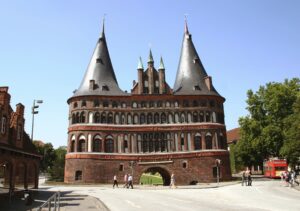 Lübeck, Germany[/caption]
Lübeck, Germany[/caption]
Overview of Lübeck
Lübeck was the queen of the Baltic Sea Region’s Hanseatic cities. It still is, and that is not without reason. Majestic churches and countless houses, monasteries and other medieval buildings stand as evidence of the immense wealth that came to the city over the centuries with trade routes.
The old town of Lübeck is located on an island in the Trave River, which provides a natural boundary for this part of the city where everything is within walking distance. In addition, the river and its banks are like a blue-green belt around the city, which can be enjoyed in many places, for example on a river boat, where you sail the Trave around the center of Lübeck.
There are many interesting sights in Lübeck’s center with the city’s many great medieval churches at the forefront. Marienkirche and Lübeck cathedral are the two most well-known churches, which form the famous skyline of the Hanseatic city. You can also enjoy nice squares and other famous buildings such as the city hall and the city gates Holstentor and Burgtor.
About the Whitehorse travel guide
Contents: Tours in the city + tours in the surrounding area
Published: Released soon
Author: Stig Albeck
Publisher: Vamados.com
Language: English
About the travel guide
The Whitehorse travel guide gives you an overview of the sights and activities of the Canadian city. Read about top sights and other sights, and get a tour guide with tour suggestions and detailed descriptions of all the city’s most important churches, monuments, mansions, museums, etc.
Whitehorse is waiting for you, and at vamados.com you can also find cheap flights and great deals on hotels for your trip. You just select your travel dates and then you get flight and accommodation suggestions in and around the city.
Read more about Whitehorse and Canada
Canada Travel Guide: https://vamados.com/canada
City tourism: https://visitwhite-horse.ca
Main Page: https://www.vamados.com/
Buy the travel guide
Click the “Add to Cart” button to purchase the travel guide. After that you will come to the payment, where you enter the purchase and payment information. Upon payment of the travel guide, you will immediately receive a receipt with a link to download your purchase. You can download the travel guide immediately or use the download link in the email later.
Use the travel guide
When you buy the travel guide to Whitehorse you get the book online so you can have it on your phone, tablet or computer – and of course you can choose to print it. Use the maps and tour suggestions and you will have a good and content-rich journey.


Salzspeicher is the name of six warehouse buildings along the Trave river. They were built in the period 1579-1745. The buildings were used to store the salt that was shipped here from the Lüneburg area. The salt was exported not least to Scandinavia, where large fish catches had to be preserved. Today, shops are set up in the old and beautiful houses.
Saint Peter’s Church was first consecrated in 1170, but a major building work of a three-nave late Romanesque church building took place 1227-1250. In 1290, a Gothic map was added, and in the 15th century, the interior of the church came to be five naves. During the bombing in 1942, the church was hit and burned to the ground along with the beautiful interior. The church was rebuilt in the years up to 1987, but already in 1961 the beautiful church tower was completed.
In the 108 meter high tower there is a viewing platform at a height of 50 metres. With its location in the middle of Lübeck’s old town, there is a beautiful and exciting view from here. The church is not used for church services today, but instead for various exhibitions and concerts.

Lübecker marzipan is probably something most people know, and since 1806 the company Niederegger has been producing the sweet almond mass here in the city. The so-called Marzipan-Salon is located on the 2nd floor of Niederegger’s building, and here you can learn about marzipan production and the history of marzipan, among other things.
The ground floor of the building is a tempting shop with marzipan in all shapes and colors, and at the back and on the 1st floor is a patisserie, where you can of course taste cakes with marzipan. The whole building is very beautifully decorated.
The Lion Pharmacy is one of Lübeck’s oldest preserved secular buildings; parts of the structure even date back to the time before the great city fires of the 13th century. The current brick house with a jagged gable was built in 1230 by the councilor Bertram Stalbuk. The Gothic profile on the main gable was added during a rebuild in 1358, while the house’s smaller gable dates from 1403.
Over the centuries, the house was home to several of the city’s prosperous families; among other things, some of Lübeck’s mayors have lived here over time. The place became a pharmacy in 1812, when the pharmacist Adolf Christoph Sager moved in. The pharmacy was destroyed in 1942, but later rebuilt.

This house is the setting for Thomas Mann’s Nobel Prize-winning novel Buddenbrook. The Mann family lived in the beautiful old town house from 1758, and it is now set up as a museum with a fine 19th-century interior.
At the museum you can see an exhibition about the brothers Thomas and Heinrich Mann, and there is also an exciting and quite lively exhibition about the novel Buddenbrook.
St. Catherine’s Church is the only preserved monastery church in Lübeck, and it is today set up as a museum church. It was built in noble brick Gothic as part of a Franciscan monastery dedicated to Saint Catherine of Alexandria. The Franciscans acquired the plot of land in 1225 and built a monastery and the first church. The current church is from the 14th century.
After the Reformation in 1531, the monastery buildings were arranged as a Latin school and from the 17th century also as a library. The church continued to function as a church. In 1841, the first collection of works of art from the Middle Ages was established in the choir, and the rest of the church was used for exhibitions and concerts throughout the 19th and early 20th centuries.
When many of the city’s other churches were destroyed during a bombardment in 1942, St. Katharina Church was once again established and used as a church. Since 1980 it has been a museum, and there is still a school on the monastery grounds; Katharineum.
Inside the museum you can see, among other things, the Venetian Tintoretto’s mural of the Resurrection of Lazarus and a copy of Bernt Notke’s statue of St. George and the Dragon. The original stands at Storkyrkan in Stockholm.
On the facade of the church is the interesting tilework by Ernst Barlach and Gerhard Marck’s interesting figure frieze, which dates from the years 1929-1949.

The castle gate is the northernmost of Lübeck’s four old city gates. It was built in 1444 in late Gothic style, but the tower cap was only added in 1685. The gate’s name refers to the former Lübeck Borg/Lübecker Burg, which was located above the Trave river and which in 1227 was converted into a monastery.
Originally there was only one entrance through the main gate, but increased traffic has given three new accesses to and from the city. They came into being from 1850 to the end of the 1920s.
Historically, it was precisely through the Castle Gate, French troops came through the city’s defenses on 6 November 1806 during the Battle of Lübeck, which resulted in French rule over the free city.
The writer, artist and Nobel laureate Günter Grass lived for many years in Lübeck, where this museum is now located. Among Grass’s works is Bliktrommen (Die Blechtrommel) from 1959, and he received the Nobel Prize in Literature in 1999.
The museum tells a wide story about Günter Grass and his works. There are more than a thousand effects in the exhibition; including manuscripts, lithographs and sculptures.

Lübeck’s cathedral is the city’s oldest preserved building. After the city became a bishop’s seat in 1160, a large church had to be built, and Henry the Lion laid the foundation stone for the cathedral 13 years later.
It is said that Henry the Lion competed with his son as to which of the two could finish building a tower first. The son won, and on top of that he built his own tower 2 meters higher than the father’s. The height of the cathedral is 114 metres, and with 130 meters in length it is an impressive church.
The new Romanesque brick church replaced a wooden church on the same site. It was completed in 1230 and consecrated in 1247. In the years 1266-1335, the church was rebuilt in Gothic style, and in this connection the side naves were built to the same height as the central nave.
During an air raid in 1942, the cathedral was heavily damaged, but fortunately part of the inventory was saved. Reconstruction after the war did not begin until 1960, and in 1982 the work was completed.
Among the interior of the church are several burial chapels, Bernt Notke’s 17 meter high Triumfkors/Triumphkreuz from 1477 and the pulpit from 1586. The beautifully decorated lecture room is like the triumphal cross from 1477, and the large church clock on it is from 1628.
Similar to Lübeck Travel Guide
